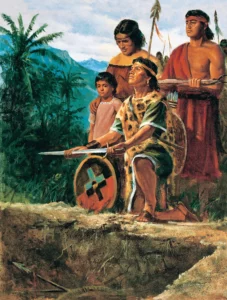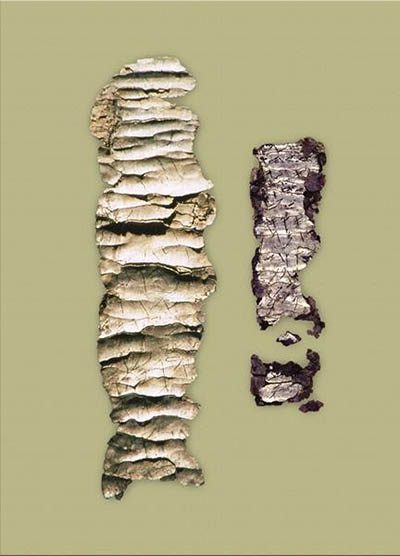 As I ponder the many messages of Christmas, one in particular comes from a dramatic story in the Book of Mormon about a large group of Lamanites, the “Anti-Nephi-Lehies” or people of Ammon, who repented of their violence, hate, and other sins. They even made a covenant not to take up their weapons again, but buried them to ensure that they would not return to their old violent ways. Indeed, they were willing to die rather than return to their old ways. One thousand and five of them, presumably their men with the women and children being more safely away at some distance, were killed when they went forth without weapons, prostrating themselves on the ground, to meet an angry army of their fellow Lamanites who saw them as traitors for adopting the Nephite religion. The attack was soon called off as many in the Lamanite army were stung with the horror of the innocent people they had killed and also dropped to the ground, joining their victims and becoming part of that society of Lamanite converts (Alma 24).
As I ponder the many messages of Christmas, one in particular comes from a dramatic story in the Book of Mormon about a large group of Lamanites, the “Anti-Nephi-Lehies” or people of Ammon, who repented of their violence, hate, and other sins. They even made a covenant not to take up their weapons again, but buried them to ensure that they would not return to their old violent ways. Indeed, they were willing to die rather than return to their old ways. One thousand and five of them, presumably their men with the women and children being more safely away at some distance, were killed when they went forth without weapons, prostrating themselves on the ground, to meet an angry army of their fellow Lamanites who saw them as traitors for adopting the Nephite religion. The attack was soon called off as many in the Lamanite army were stung with the horror of the innocent people they had killed and also dropped to the ground, joining their victims and becoming part of that society of Lamanite converts (Alma 24).
The Anti-Nephi-Lehies far excelled the Nephites in their faith and righteousness. Not a one of them ever fell away from the faith (Alma 23:6-7; 27:27). We often admire their courage and faith, and their willingness to die rather than abandon the covenant they had made. There was something unusual in the composition of this marvelous group that we don’t seem to discuss much. This was not just a gathering of like-minded friends who all became converted. It was a congregation that included many widows and fatherless children, as well as some of the men who killed the missing husbands and fathers. Have we pondered what this means? What does a mother say to her child when the child points at somebody and asks, “Mommy, is that the man that killed Daddy?” Even if that question was never openly asked, the new additions to their group must have known it could be asked. How could they bear to remain part of that group?
The penitent warriors who joined the converts were part of this people that did not fall away. It seems that they belonged and stayed together, surrounded with visible reminders of their crimes. How could this be possible? In our society, it’s so hard for penitent people who have committed much less serious crimes to stay active in a ward where others know of their past, especially when the ward includes victims of those crimes. How could a man who killed an unarmed man in a brutal massacre join the community he victimized and never fall away? For such a thing to have happened, a miracle must have occurred, many miracles at an individual level: the miracles of forgiveness as victims abandon their anger and welcome the penitent offender in their midst. The glue of forgiveness must have permeated this society, standing as a daily embrace to hold former assailants and killers in their fold, serving as a reminder of the reality of their Savior’s forgiveness and love made possible the grace of Christ and His infinite Atonement. This glue would keep all their members in the fold, a people “distinguished for their zeal towards God, and also towards men; for they were perfectly honest and upright in all things; and they were firm in the faith of Christ, even unto the end” (Alma 27:27). How marvelous the miracle of forgiveness, especially the miracle that allows us as victims to not just calm our anger but to treat the offender with love.
As our society becomes more hostile toward one another, more violent and threatening at times, we may face similar episodes. We may see growing scenes of violence and anger in our midst, and yet miracles of conversion as those who hurt us are touched by the Spirit and by the ministering of faithful servants of God, and come seeking our forgiveness, looking for refuge in our midst. Will we have the faith to forgive and make them feel loved in our wards and neighborhoods? When our former enemies come to stand in the waters of baptism, after they have dried off, will they see and feel and that they are among brothers and sisters who accept their repentance and welcome them in the fellowship of Christ? Will future historians be able to write about our wards and our people the way Mormon wrote about the people of Ammon? I hope we can seek to follow their example of charity expressed through forgiveness. It’s a glue we need in abundance.
Background on the Anti-Nephi-Lehies
The story of the Anti-Nephi-Lehies is told in Alma 23 and 24, and their famous young men, the stripling warriors, are later discussed in Alma 53:16–19 and vv. 56–58. The Anti-Nephi-Lehies were a large group of Lamanites in the first century before Christ in the New World who were converted through the ministry of the sons of Mosiah. The sons of King Mosiah were royal princes of the Nephite people who turned down the opportunity to reign and instead chose to serve God as missionaries to the Lamanites after their dramatic and miraculous conversion, going from arrogant enemies of the Church to humble servants of God. The story given in the book of Alma is given largely from the perspective of their leader, Ammon, whose heroism, diligence, and faith led to miraculous conversions of King Lamoni and the king over all the Lamanites, the unnamed father of King Lamoni. Thousands of fellow converts soon joined them. The converts, led by a brother of King Lamoni who took a new name, Anti-Nephi-Lehi (for some possibilities of what the “Anti” term might mean, see the Book of Mormon Onomasticon), and the body of converts became known as the Anti-Nephi-Lehies or slightly later as the people of Ammon. The Book of Mormon discusses them in Alma 23 and 24, and their famous young men, the stripling warriors, are later discussed in Alma 53:16–19 and vv. 56–58.
Soon after their conversion, they faced the wrath of their fellow Lamanites who saw these converts to Nephite religion as traitors worthy of death. The Anti-Nephi-Lehies, however, refused to fight. They had been deeply stung by the murders they had committed prior to their conversion, and felt that they might return to their wickedness and hate if they took up the sword again. Thus, in a dramatic scene, Anti-Nephi-Lehi leads them in making a covenant to not take up arms. They bury their weapons of war and decide they would rather face death than risk losing their souls by turning again to violence. And then comes a terrible trial of their faith, as told in Alma 24:
20 And it came to pass that their brethren, the Lamanites, made preparations for war, and came up to the land of Nephi for the purpose of destroying the king, and to place another in his stead, and also of destroying the people of Anti-Nephi-Lehi out of the land.
21 Now when the people saw that they were coming against them they went out to meet them, and prostrated themselves before them to the earth, and began to call on the name of the Lord; and thus they were in this attitude when the Lamanites began to fall upon them, and began to slay them with the sword.
22 And thus without meeting any resistance, they did slay a thousand and five of them; and we know that they are blessed, for they have gone to dwell with their God.
23 Now when the Lamanites saw that their brethren would not flee from the sword, neither would they turn aside to the right hand or to the left, but that they would lie down and perish, and praised God even in the very act of perishing under the sword —
24 Now when the Lamanites saw this they did forbear from slaying them; and there were many whose hearts had swollen in them for those of their brethren who had fallen under the sword, for they repented of the things which they had done.
25 And it came to pass that they threw down their weapons of war, and they would not take them again, for they were stung for the murders which they had committed; and they came down even as their brethren, relying upon the mercies of those whose arms were lifted to slay them.
26 And it came to pass that the people of God were joined that day by more than the number who had been slain; and those who had been slain were righteous people, therefore we have no reason to doubt but what they were saved.
The Lamanite army soon abandoned the slaughter and went on to attack a nearby Nephite city instead, destroying the wicked city of Ammonihah. The surviving Anti-Nephi-Lehies with over 1,000 of their penitent killers now among them, sought refuge among the Nephites. They were willing to be their slaves to make up for their many crimes against the Nephites, but instead, the Nephites mercifully granted them land, the land of Jershon (also check out the Book of Mormon Onomasticon on this name), and military protection, as reported in Alma 27. Their example of faithfulness continues to inspire us today and also reminds us that sloppy stereotypes about the Book of Mormon, such as Nephites = good, Lamanites = bad, are contrary to the remarkably inclusive teachings of that sacred text. See, for example, “The Inclusive, Anti-Discrimination Message of the Book of Mormon” by David M. Belnap in
Interpreter: A Journal of Latter-day Saint Faith and Scholarship. There is always much more depth than meets the casual eye in this profound sacred record.











Thank you, Jeff, for these wonderful insights. In making their covenant of peace, their king, Anti-Nephi-Lehi, referenced the “many murders” that they had committed, but I had only thought of this in terms of their raids and wars on the Nephites. The challenge of accepting into their covenant of peace fellow Lamanites who had just murdered their own husbands and fathers had never occurred to me.
It’s interesting that the deficit of men created by these murders was now more than overcome by the new converts. One wonders . . . might any of the new converts actually have eventually married the widows of the men they had slain? If not, I am certain that they were diligent in providing for the widows and orphans. Talk about forgiveness!